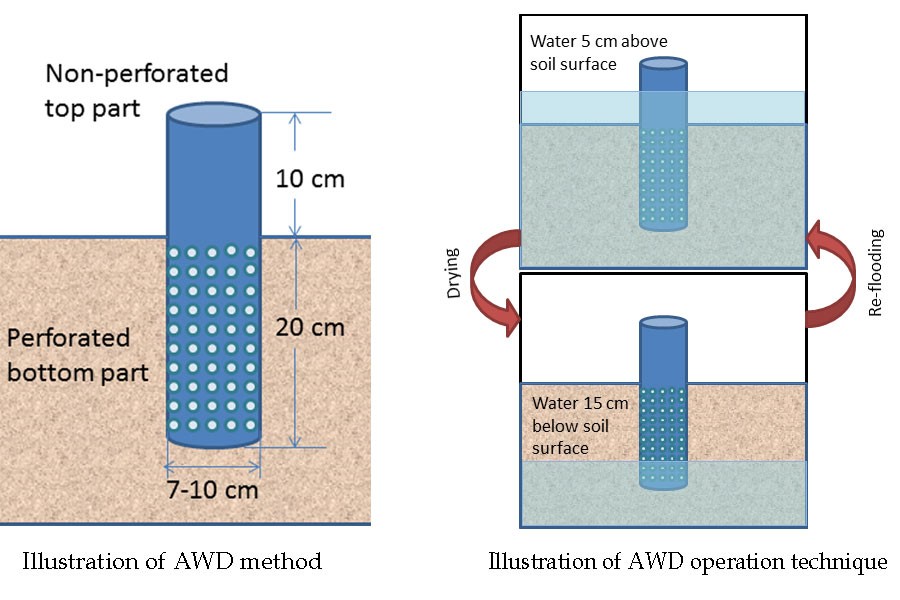Smart irrigation technology for sustainable agriculture

Polin Kumar Saha & Krishibid Khairul Kabir Mollah
Published :
Updated :

In the circumstance of global energy crisis and water insufficiency, rice production system is being changed with the policy to produce more with minimum amount of water. In Bangladesh, use of groundwater in a massive scale for Boro rice is the main cause of declining groundwater tables, especially in the Rangpur Division -- now a burning issue at the national level.
In order to protect sustainability of modern agricultural practices, many smart technologies are being used. The system of Alternate Wetting and Drying (AWD) is one, and can be introduced in saving water and energy, where both farmers and pump-owners are able to save around 30 to 35 per cent of their irrigation water requirements.
In Bangladesh around 2.36 million hectares of land (Yearbook of Agriculture Statistics-2016) are under irrigated Boro cultivation where AWD technology can be applied. With the introduction of AWD technology, saving on electricity cost equivalent to Tk 2.5 billion or fuel cost equivalent to Tk 3.5 billion annually is possible, according to experts.
AWD is a water-effective technology that farmers can apply to reduce their irrigation water feeding in rice fields without decreasing the yield. In AWD, irrigation water is applied at intervals, a few days after the normally supplied water. Trials have shown that AWD method saves about 365 mm irrigation water (about 27 per cent) over the traditional irrigation practices. There is no noticeable negative effect of AWD irrigation system on crop yield.
The sustainability management system in agriculture demands that water consumption must be reduced to preserve water resources. But in reality, about 70 per cent of the fresh water is being used to irrigate rice lands in Bangladesh. It has been estimated that 3000-5000 litres of water are required to produce 1.0 kg of rice.
AWD also helps reduce greenhouse gas (GHG) emissions, mostly methane, by up to 50 per cent. Methane emissions are caused by flooding of rice fields. Rigorous research by scientists from International Rice Research Institute (IRRI) and its partners have helped AWD system to progress into one of the most advanced GHG mitigation methods in the agriculture sector. AWD could thus become a key component for the mitigation of GHGs in many Asian countries. Farmers in Bangladesh, the Philippines, and Vietnam are now being trained on the use of AWD by the national agricultural research and extension organisations of respective countries.
In field experiment, a tube/pipe made of PVC is typically used in the AWD method. The tube monitors the water depth and measures water availability in the field below the soil surface. Here the normal practice is to use a pipe of 7-10 cm diameter and 30 cm long, with holes at the bottom. The bottom of the perforated portion remains underneath the soil surface and the non-perforated 10 cm above the surface. The perforations allow the water to come inside the tube from the soil, where a scale measures water depth below the soil surface.
Some factors (e.g. evapotranspiration, seepage, and percolation) may decrease the water level after the irrigation in the crop field. Precautions are required, especially at time of flowering stage of rice, when the field must be kept sufficiently wet. But after flowering, especially at the mid-season and late season (grain filling and ripening stages), the water level should drop down below the soil surface to 15 cm before re-irrigation. As regards application of fertiliser, nitrogen fertiliser may be applied preferably on dry soil just before re-irrigation.
AWD appears to be a promising sustainable technology and hence efforts are underway to popularise it in our ecosystems. Water productivity and reducing GHGs emissions are the key factors that are driving scientists to refine the technology for every ecosystem and make it more farmer-friendly. Studies, however, on diseases like blast and usage change in pesticides are much warranted. Further, nutrient management, particularly those of micronutrients and breeding varieties, especially suited for this system of rice cultivation, would take the technology to the next level.
Polin Kumar Saha & Krishibid Khairul Kabir Mollah are environmental professionalsin the private sector.


 For all latest news, follow The Financial Express Google News channel.
For all latest news, follow The Financial Express Google News channel.